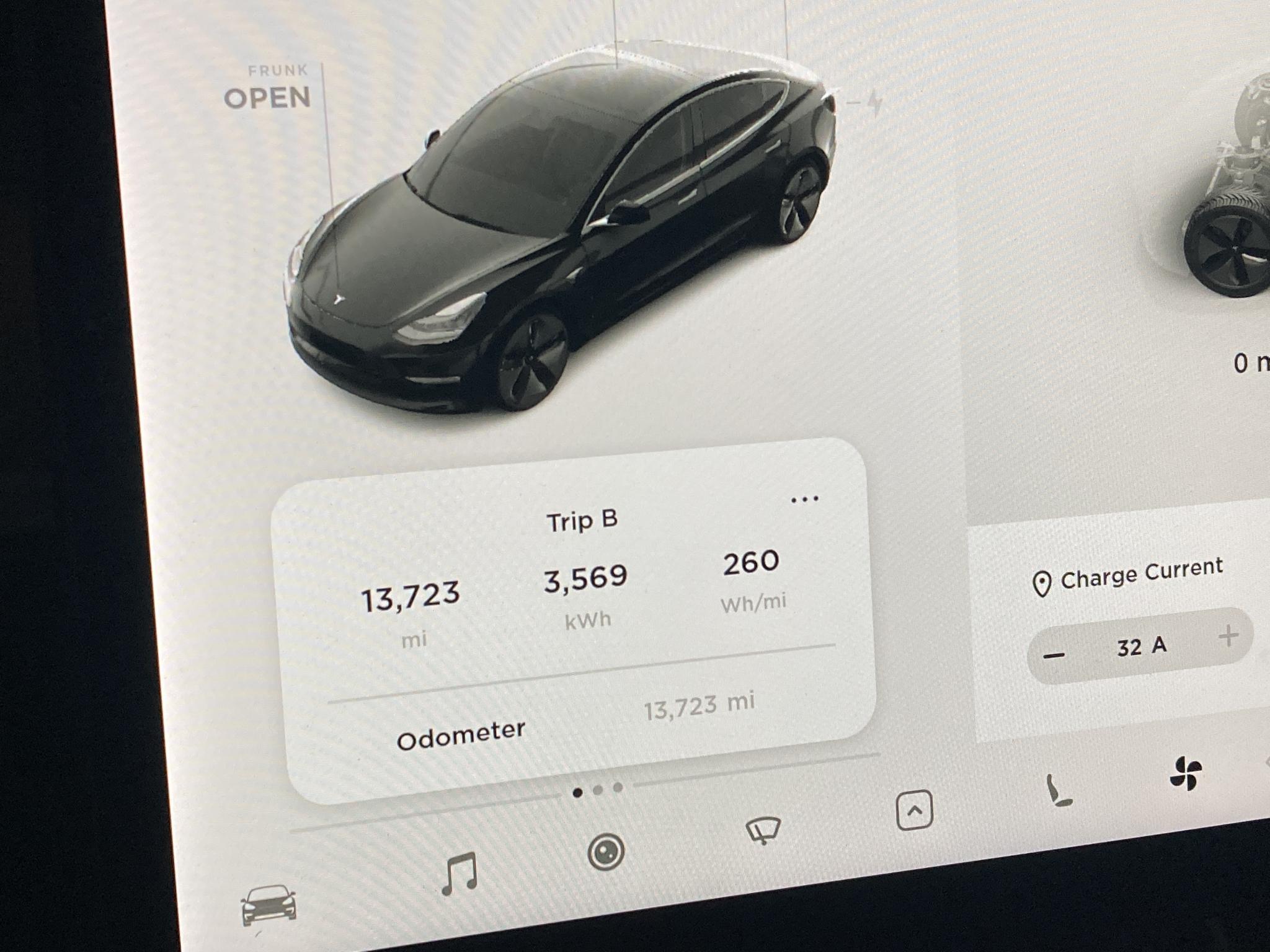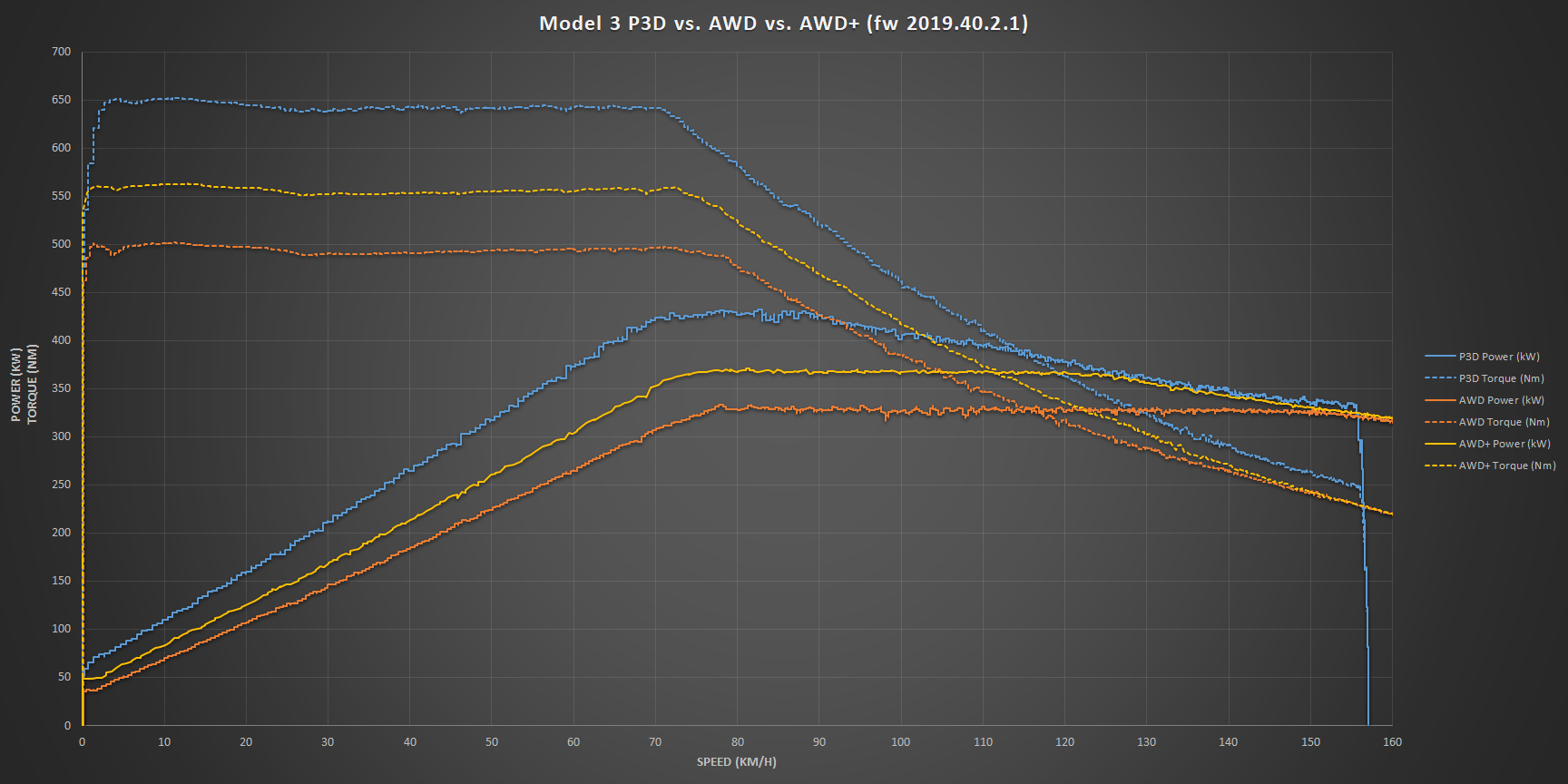In reply to Keith Tanner :
Just thought I'd tell you back in the early 1980's I was selling Clark electric forklifts with regenerative braking. And several other features I read Tesla is offering.
These were big heavy duty ( up to 12,000 capacity ) that were used non stop around the clock in production like food warehouses, auto manufacturing, aircraft maintenance, etc.
Aside from indoor air quality they were used because of low maintenance costs.
I discovered that there is an actual trip meter on the car that includes energy use. I've never reset it...so here you go, lifetime consumption.

EPA range is given as both a maximum number and an efficiency number, and the combined efficiency number for our 2019 Long Range is...260 Wh/mi. Right on the money. That's actually pretty cool.
I can tell you it's not from hypermiling. I was following Janel around town the other day while driving a turbo ND with 245s and race suspension and I was having to hustle to keep up. She enjoys that her car is "zippy".
In reply to Keith Tanner :
That consumption figure is astounding-- the i3 I had would run between 3 and 3.5 miles per kWh or 285-33o Wh/mile in equivalent units. Mostly 70-75 mph driving.
It's definitely working well! And the 2021s are rated even better thanks to some gradual improvements. I'm just impressed that it's nailing the predicted numbers. Looks like the estimates are pretty solid.
Also, we pay 9.9c/KWh for power at home. So that means about $350 for fuel so far, ignoring the fact that some of it came from Superchargers (free for us until this October, 29c or so after that) and some from hotel chargers (no cost). We didn't get this car to save money but it's a nice bonus.

84FSP
UltraDork
6/26/21 9:53 p.m.
Really digging this thread sir. Pleased to hear how happy you guys are with the car after some real world miles.
Keith just wondering if you did the performance software upgrade to yours yet?
No, lack of acceleration is not currently a problem so I haven't felt the need to drop $2k on making it accelerate harder :)
Agreed they are no slouch. Just wondering on how the long range will compare to the performance model now after the bump
Looks like it splits the difference pretty nicely. I posted a dyno chart on page 13 of this long meandering thread. Note that the Performance does have a more powerful rear motor than the Long Range so they'll never reach full parity.

Note that we do have another Denver trip coming up this weekend - the first one since February 2020. The weather will likely involve less snow :) Part of that trip will involve dropping off a transmission for rebuild so I may or may not get approval to take the nice car instead of something more...patinated.
In reply to Keith Tanner :
This thread is part of the reason we are replacing her Honda CRV with a Tesla. Part of me wants to do a running cost account. Starting from purchase and going down as we own it.
The idea that the per mile ownership cost curve will gradually drop until the lower cost of energy ( and maintenance?) would dramatically beat a comparable ICE
Could you comment on any maintenance costs you've had during your ownership?
Here is a list of all the maintenance scheduled and performed so far (14,000 miles, about 18 months):
- tire rotation
We do have a major service coming up at 2 years: the HVAC filter should be replaced. Given the smoke from the fires last year, that's a pretty good idea. Looks like there are two of them at $17 each from Tesla. Or I can upgrade to a HEPA filter if I want.
Also, brake fluid flush.
In reply to Keith Tanner :
Wow, at this point in a normal ICE. There would be oil changes and possibly even brake pad replacement.
In reply to Keith Tanner :
That's jibes with my friend's experience with his Model 3. He's had his for about the same length of time as you, pushing about 23,000 miles. We just did his 2nd tire rotation in my driveway. His brake pads looked excellent, like new almost. His doesn't have the performance software either, but the acceleration is something akin to having God shove his boot up your arse. I've been pushed back into my seat before, but never felt my body actually sink into the upholstery while merging onto the freeway. If you need any more shove than a base Model 3 on the street, you're either Dom Toretto's other brother or just bonkers.
The friction brakes get very little use with the amount of regen on tap. It's pretty typical for me to not touch the brakes at all during a drive. I can see them being almost a lifetime part on a daily driver. Track use, on the other hand, would probably punish them pretty badly.
One interesting side effect of using the regen is that it rewards heads-up driving. You end up being very smooth and anticipating what's going to happen because you are quite aware anytime you have to brake harder than "normal". It's basically the equivalent of having a light flash at you anytime you have to decelerate harder than a certain amount, you adapt your driving to keep the light off. Also, for some reason I love the feel of the car decelerating off the highway under regen. I suspect it's pulling a lot out of the rear wheels, it has a different feel than friction brakes.
I just read all 22 pages of this thread, and I have to say this is helping my case with the wife for a model Y as a Pathfinder replacement... My only concern is snow/mud concerns. We live on about .5 mile of dirt roads that are questionably maintained, and accessibility is important.
It's got a really good traction control system in my experience. As long as you don't have a ground clearance problem, you should have no trouble getting power down. The Tesla can manage torque delivery at each axle independently in a very precise manner and will play the usual brake games to shuffle torque from side to side. So it's better than a locked center diff 4WD system would be.
This should also apply to any AWD EV.
Keith Tanner said:
It's got a really good traction control system in my experience. As long as you don't have a ground clearance problem, you should have no trouble getting power down. The Tesla can manage torque delivery at each axle independently in a very precise manner and will play the usual brake games to shuffle torque from side to side. So it's better than a locked center diff 4WD system would be.
This should also apply to any AWD EV.
Thanks, that makes sense. Snow clearance is a slight* concern, but we have a plow truck, and well, if it snows more than 24" aint nobody getting out until the storm is over...

Harvey
SuperDork
7/7/21 2:43 p.m.
I keep wanting one, but I have no good excuse to get one and my wife hates the looks of them.

mattm
Reader
7/7/21 9:17 p.m.
Keith Tanner said:
Here is a list of all the maintenance scheduled and performed so far (14,000 miles, about 18 months):
- tire rotation
We do have a major service coming up at 2 years: the HVAC filter should be replaced. Given the smoke from the fires last year, that's a pretty good idea. Looks like there are two of them at $17 each from Tesla. Or I can upgrade to a HEPA filter if I want.
Also, brake fluid flush.
At 55k on my 2019 Model S and my maintenance cost breakdown, outside of tires, is as follows:
1 set of wiper blades.
I have tracked tread depth waiting for an indication to rotate tires and it has yet to come. On my AWD S the tire wear is basically equal. Maximum of a 1mm spread between front and rear.
In reply to Harvey :
I'm getting closer and closer to making a decision. Thought about getting an i3 for a while to get my feet wet in the electric car phase but not sure it's apples to apples with a Tesla
In reply to Keith Tanner :
The brake pads on hybrids and EVs are even more susceptible to seizing due to lack of use compared to ICE vehicles. IIRC, Tesla recommends disassembly and cleaning/lubricating every two years. Obviously, your local salt content will play a role in how critical this is, personally I find two years to be a bit long, that's a 7000-10,000 mile service here and half the time a hammer is required to get the pads out. If the brakes truly never get used, the rotors will be rust balls by then, too.
Still a small price to pay, but brakes are one of those "use 'em or lose 'em" things like tires.
In reply to Pete. (l33t FS) :
It'll be interesting to see if the software will eventually include some sort of occasional brake activation mode to prevent that from happening, much like Diesel go into DPF regen.
In reply to Pete. (l33t FS) :
More cars should have "lube the brake calipers" in their service schedule.
The car does clamp the brakes on as a hold when it comes to a stop, so they do get exercise. But I can see how the rotors might get crusty.
Keith Tanner said:
We do have a major service coming up at 2 years: the HVAC filter should be replaced. Given the smoke from the fires last year, that's a pretty good idea. Looks like there are two of them at $17 each from Tesla. Or I can upgrade to a HEPA filter if I want.
I just did this on my neighbor's Model3 last weekend. T25 screwdriver, remove two screws and swap the filters. Took 5 minutes, mostly because the top screw is somewhat hidden.
She called me as she did not have a torx screwdriver and I was surprised Tesla would sell her the filters. For some reason I had it in my mind that Tesla was somewhat protective of selling parts to owners, glad it is not true.
In reply to Slippery :
That's the story we're always told, but in the case of air filters it is apparently not true. I have a parts fiche for it and there are some major (like the left side stamping) body parts at least that are only sold to approved shops. Haven't done a deep dive into it yet.




































